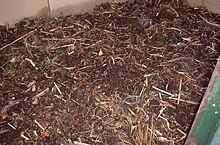Vermicomposting is a method of preparing compost during which earthworms are mixed with soil in a pit, along with waste materials that are obtained from plants and animals.
Benefits
Soil
- Improves its physical structure[citation needed]
- Enriches soil with micro-organisms (adding enzymes such as phosphatase and cellulase)
- Microbial activity in worm castings is 10 to 20 times higher than in the soil and organic matter that the worm ingests [28]
- Attracts deep-burrowing earthworms already present in the soil
- Improves water holding capacity[29]
Plant growth
Economic
- Biowastes conversion reduces waste flow to landfills
- Elimination of biowastes from the waste stream reduces contamination of other recyclables collected in a single bin (a common problem in communities practicing single-stream recycling[30])
- Creates low-skill jobs at local level
- Low capital investment and relatively simple technologies make vermicomposting practical for less-developed agricultural regions
Environmental
[edit]As fertilizer

Mid-scale worm bin (1 m X 2.5 m up to 1 m deep), freshly refilled with bedding
Vermicompost can be mixed directly into the soil, or steeped in water and made into a worm tea by mixing some vermicompost in water, bubbling in oxygen with a small air pump, and steeping for a number of hours or days.
The microbial activity of the compost is greater if it is aerated during this period. The resulting liquid is used as a fertilizer or sprayed on the plants.
The dark brown waste liquid, or leachate, that drains into the bottom of some vermicomposting systems as water-rich foods break down, is best applied back to the bin when added moisture is needed due to the possibility ofphytotoxin content and organic acids that may be toxic to plants.[9]
The pH, nutrient, and microbial content of these fertilizers varies upon the inputs fed to worms. Pulverized limestone, or calcium carbonate can be added to the system to raise the pH.
Climate and temperature
The most common worms used in composting systems, redworms (Eisenia foetida, Eisenia andrei, and Lumbricus rubellus) feed most rapidly at temperatures of 15–25 °C (59-77 °F). They can survive at 10 °C (50 °F). Temperatures above 30 °C (86 °F) may harm them.[13] This temperature range means that indoor vermicomposting with redworms is suitable in all but tropical climates.[14] (Other worms like Perionyx excavatus are suitable for warmer climates.[15]) If a worm bin is kept outside, it should be placed in a sheltered position away from direct sunlight and insulated against frost in winter.



